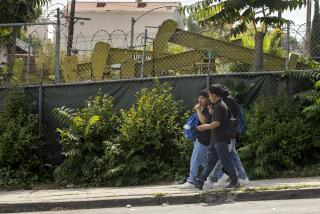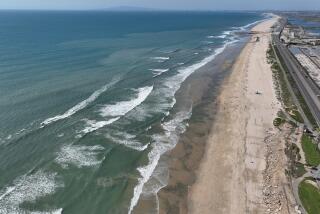Workers put in 12-hour days at Santa Barbara County oil cleanup site
- Share via
SANTA BARBARA — Clad in white protective suits and yellow hard hats, the workers knelt below a jagged cliff-side, packing oil-saturated sand into plastic bags.
Coin-sized tar balls and oil-stained kelp washed in with the waves at the once-pristine beach at El Capitan State Park as the sun baked workers cleaning the Santa Barbara coastline after last week’s oil pipe rupture.
About noon, Tony Fedota arrived in an all-terrain vehicle, weaving between large blackened boulders to bring water.
“Please, please, please be honest with me,” Fedota, a supervisor with Ponder Environmental Services, told half a dozen crew members as they unzipped their oil-stained protective suits. “Nobody is dizzy, nobody has cotton mouth, nobody is feeling nauseous?”
The workers gave him the thumbs-up sign as Fedota reached into a large cooler full of water bottles. “I’m the water boy today,” Fedota said as he handed out the plastic bottles. “Sip, don’t gulp. It will shock your system.”
Tuesday’s oil spill has transformed a scenic strip along Santa Barbara’s coastline from a beach-goer’s paradise into a massive worksite as more than 650 workers have been drafted to assist in the cleanup effort. The team includes federal and state employees from agencies such as the California Office of Emergency Services and the U.S. Coast Guard as well as environmental contractors hired by the company that owns the pipeline, Plains All American Pipeline.
Members of the public also have insisted on helping despite being turned away from Refugio State Beach, which was saturated with oil. Officials say many of the volunteers don’t have the necessary training to safely remove toxic oil deposits.
The work is taxing. Cleanup crews put in 12-hour shifts and need hourly water breaks so they don’t overheat from working in hot Tyvek protective coveralls.
State parks that normally play host to campers and surfers over the Memorial Day weekend are instead filled with massive bins holding oil-contaminated soil and weary workers eating foil-wrapped burritos during lunch breaks. The coastline is dotted with large work barges carrying cranes and more than 15 skimmers scooping up some of the 21,000 gallons of crude oil that gushed into the biologically rich Gaviota coast.
As of Sunday, workers had collected more than 1,400 cubic yards of oiled soil, sand and vegetation as well as 9,492 gallons of oily water. But officials say there is much more to be done and that workers will be at the site for weeks.
At El Capitan, contractors hired by the pipeline’s owners walked the beach with devices that monitor air quality for toxic pollutants such as benzene. On the beach, work paused for a few minutes as a lightly oiled seal waddled up to shore. Wildlife officials tried to rescue the animal, but the seal swam back into the water before it could be caught.
The cleanup also continued on the stretch of land above the coast where the pipe burst and sent oil rushing down a culvert into the ocean. An area stretching from the spill site and reaching under U.S. 101 and a parallel railroad track has been cleaned, but workers were still determining the best way to clean the culvert under the track, said Rick McMichael, director of pipeline operations for Plains All American Pipeline.
The U.S. Environmental Protection Agency is also developing a cleanup plan for the inland areas, an agency representative said.
As of noon Sunday, 13 oiled birds and eight oiled marine mammals had been captured, along with seven birds and four mammals that were found dead. Three sea lions and two elephant seals are being treated at the Oiled Wildlife Care Center at SeaWorld San Diego. An oil-covered sea lion brought in Thursday night died Saturday morning. Two dolphins brought to the center have also died. Necropsies are planned.
Workers along the coast finished emptying oil from the broken section of pipe Sunday. Nearly 21,000 gallons of oil was cleared from the pipe, and the estimate for the amount lost has been revised down slightly from 105,000 to 101,000, McMichael said.
Workers are now preparing to extract the ruptured section of pipe this week and send it for metallurgical testing to determine what condition the pipe was in when it burst.
Protesters from environmental groups have been warning of the dangers of using chemical dispersants in the cleanup. State officials said Sunday that dispersants would not be used.
Officials said the chemicals typically work best in open waters where ocean waves can help disperse crude oil, but they are not effective close to the shore. It would also be difficult to use the chemicals without harming local wildlife, said Yvonne Addassi, deputy administrator of the Office of Oil Spill Prevention and Response at the California Department of Fish and Wildlife.
The spill has spurred dozens of volunteers and activists to mobilize on beaches along the Santa Barbara County coast.
At Haskell’s Beach, darkly gleaming gobs of oil dot the beach more than 10 miles east of the spill. Kevin Duffy, a nearby resident who works in the microelectronics industry, was raking blackened bits of kelp and sandy globules of oil into a metal dustpan and bagging them up. Plastic trash bags were stashed into his waistband. He had cleared seven bags from the beach the day before, he said.
“It’s the gift that’s going to keep on giving,” Duffy said, scooping more oil out of the sand.
He was annoyed that a local official had stopped by Saturday and warned him he was risking his health — even as the beach remained open to barefoot toddlers and dogs romping in the surf.
“It totally undermines the will of the people to pitch in,” Duffy said.
Starting Monday, about 100 members of the public seeking to volunteer will be able to register for training and be put to work. Officials asked volunteers to register online.
Despite earlier warnings, many would-be volunteers have shown up on beaches with buckets and garbage bags.
Addassi warned that people working with oil need proper training. Inhaling oil fumes can cause headaches, vomiting, confusion and respiratory difficulties, among other problems. Workers heading onto oiled beaches like El Capitan, for example, are required to duct tape rubberized covers over their shoes and strip off contaminated coveralls before coming onto land.
“You need to understand what the hazards and risks are,” Addassi said.
But some would-be volunteers argued that turning away members of the public who want to help will slow the cleanup effort.
“If they don’t want us on the beach, well they’d better start cleaning it up,” said Tamlorn Chase, of the activist group End Oil Now, at a Sunday protest in Santa Barbara. “Otherwise, we’re going out, we’re gonna risk our health, because we risk our health by not cleaning it up.”
Twitter: @jpanzar
Times staff writer Tony Perry in San Diego contributed to this report.
More to Read
Sign up for Essential California
The most important California stories and recommendations in your inbox every morning.
You may occasionally receive promotional content from the Los Angeles Times.












